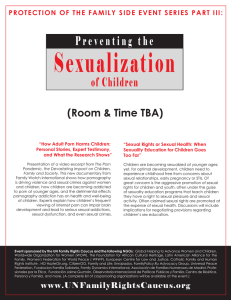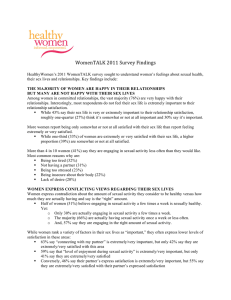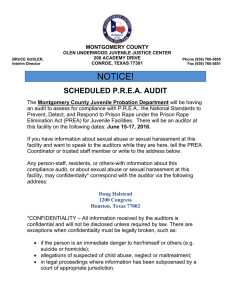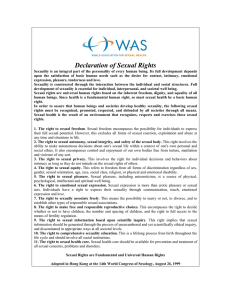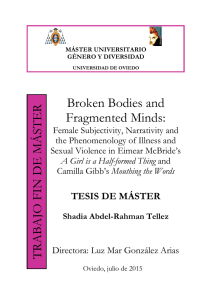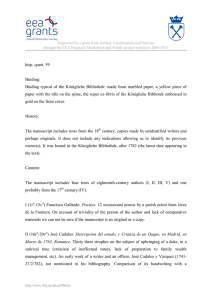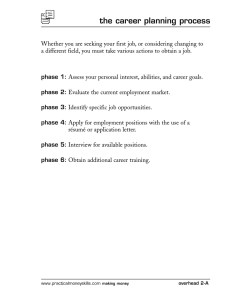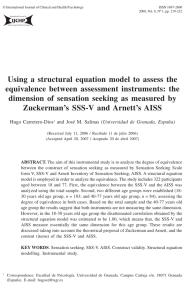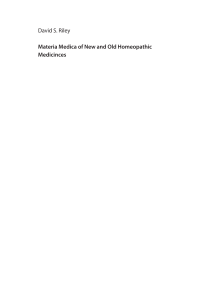Sexual sensation seeking in spanish Young men
Anuncio
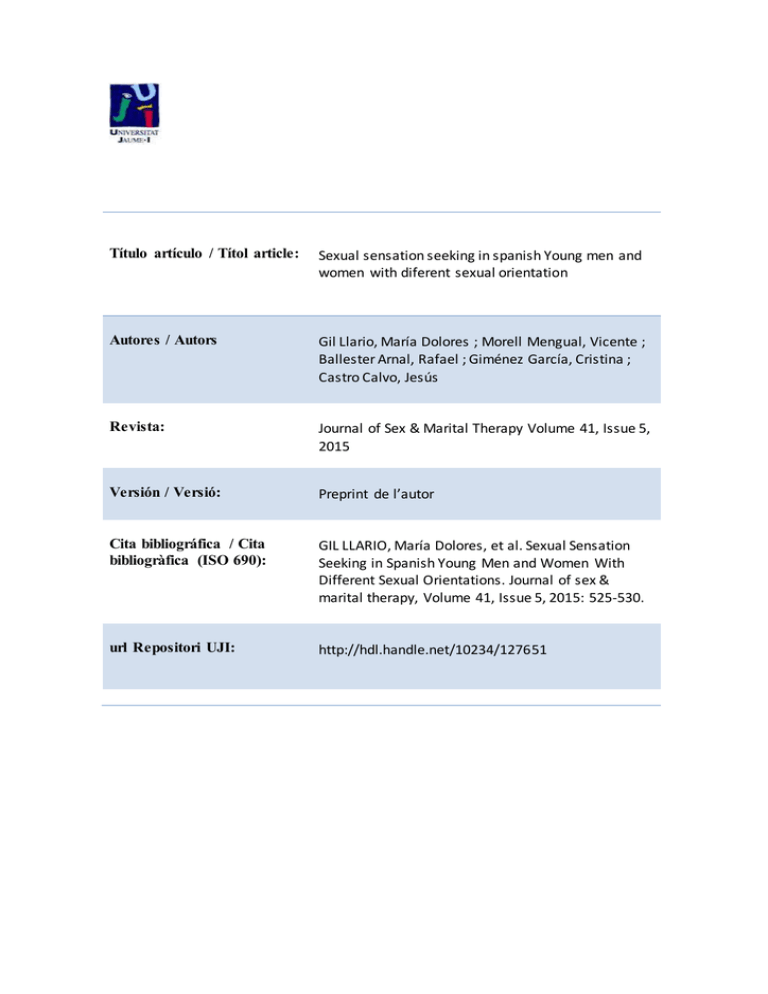
Título artículo / Títol article: Sexual sensation seeking in spanish Young men and women with diferent sexual orientation Autores / Autors Gil Llario, María Dolores ; Morell Mengual, Vicente ; Ballester Arnal, Rafael ; Giménez García, Cristina ; Castro Calvo, Jesús Revista: Journal of Sex & Marital Therapy Volume 41, Issue 5, 2015 Versión / Versió: Preprint de l’autor Cita bibliográfica / Cita bibliogràfica (ISO 690): GIL LLARIO, María Dolores, et al. Sexual Sensation Seeking in Spanish Young Men and Women With Different Sexual Orientations. Journal of sex & marital therapy, Volume 41, Issue 5, 2015: 525-530. url Repositori UJI: http://hdl.handle.net/10234/127651 ACCEPTED MANUSCRIPT SEXUAL SENSATION SEEKING IN SPANISH YOUNG MEN AND WOMEN WITH DIFFERENT SEXUAL ORIENTATION M. Dolores Gil-Llario and Vicente Morell-Mengual University of Valencia, General Study, Developmental and Education Psychology, Valencia, Spain Rafael Ballester-Arnal, Cristina Giménez-García and Jesús Castro-Calvo Universitat Jaume I, Castellón, Spain Address correspondence to Cristina Giménez. E-mail: [email protected] Abstract This study analyzes the relationship of sexual orientation and gender to Sexual Sensation Seeking. 382 participants completed the Sexual Sensation Seeking Scale, 200 men and 182 women between 17 and 29 years old. 52.46% of them self-reported heterosexual orientation while 47.64% self-reported homosexual orientation. The results showed differences with Sexual Sensation Seeking being more frequent among heterosexuals and men. There were no differences between heterosexual and homosexual men. Heterosexual women had higher Sexual Sensation Seeking scores than homosexual women. These results and their possible implications for the effective development of prevention and intervention programs in affective-sexual education are discussed. Keywords: Sexual sensation seeking; sexual orientation; gender; Spanish young; Spanish adolescents. 1 ACCEPTED MANUSCRIPT ACCEPTED MANUSCRIPT Introduction The number of new HIV infections remains a concern in Spain. The latest data published in November 2013 by the Service of Epidemiological Surveillance of HIV/AIDS (Ministerio de Sanidad, Servicios Sociales e Igualdad, 2013) indicates that transmission among men who had sex with other men (MSM) is the most important affected population. Among men, the MSM transmission accounted for 61% of new HIV diagnoses in Spain in 2012. Among women, however, heterosexual transmission is the main category, with 85% of newly diagnosed. This report highlights that the main route of transmission is sexual risk behaviors. In addition, MSM is the collective of priority intervention followed by heterosexual women (Ministerio de Sanidad, Servicios Sociales e Igualdad, 2013). One of the personality variables associated with health behavior in sexuality is Sexual Sensation Seeking (SSS). This dimension was defined by Kalichman et al. (1994) as the tendency to obtain optimal levels of sexual arousal and engaging in novel sexual experiences. People who score high in SSS usually take part in situations which are considered harmful and risky by people who score low. In adolescents and young Westerners, the SSS is related to a broader range of risk behaviors for HIV/STIs as a higher number of sexual, less use of condoms and other forms of protection during their last sexual intercourse (Voisin, Hotton, Tan & DiClemente, 2013) which are prevalent among Spanish young (Ballester, Gil, Giménez & Ruiz, 2009), or risky use of cybersex and more online sexual compulsivity (Ballester, Castro, Gil & Giménez, 2013). In particular, regarding SSS there are some comparing studies between men and women. Among the studies focused on heterosexual population, the research by Flanders, Arakawa and Cardozo (2013) and the research by Gaither and Sellbom (2003) stand out. Both of them were based on 2 ACCEPTED MANUSCRIPT ACCEPTED MANUSCRIPT American people who revealed higher Sexual Sensation Seeking for young men than for young women. As well as the study by Erol (2007) with Turkish population, who revealed higher SSS among Turkish young men comparing with women. In this sense, Ballester, Gómez, Gil and Salmerón (2012) found more sexual compulsivity in Spanish young men than in Spanish young women. In addition, there is a comparing study between men and women in homosexual population from Spain (Morell, Gil, Ballester & Castro, 2013). These studies agree the higher sexual sensation seeking for men compared with women. That is, heterosexual and homosexual men reveal higher levels in SSS than heterosexual and homosexual women. As regards the comparing studies of SSS, between heterosexuals and homosexuals, there are also few studies. The first one based on men (McCoul & Haslam, 2001) evaluated sexual sensation seeking in heterosexual and homosexual adult men from New York. This revealed more scores of SSS Scale for homosexual men than heterosexual men. Later, Bancroft et al. (2004) concluded trough different studies that sexual disinhibition would be a predictor for heterosexuals and homosexuals, connecting sexual risk behavior and SSS. The second study, based only on women (Farely, 1993), showed higher scores in SSS for homosexual women, as well as more disposition toward sexual fantasy, stronger sexual desire and higher frequencies of sexual activity. Therefore, there is still unknown if heterosexual women will reveal more or less SSS levels than homosexual men. This is because there is a lack of comparative studies between heterosexual and homosexual population in men and women (Flanders et al., 2013). 3 ACCEPTED MANUSCRIPT ACCEPTED MANUSCRIPT For that reason, because of the gap of knowledge about this topic, the main contribution of this research is to analyze the role of sexual orientation, in men and women, on sexual sensation seeking. Method Participants Participants were 382 young people, 52.36% (n = 200) were male and 47.64% (n = 182) were women. The 52.46% of the sample (50 men and 42 women) self-reported being heterosexual whereas 47.64% (50 men and 40 women) self-reported being homosexual. The limited number of participants who self-reported bisexual made difficult the comparative analyses (6 men and 4 women), consequently we had to eliminate them. education and 27.89% had primary or secondary education. Outcome measure Escala de Búsqueda de Sensaciones Sexuales (Sexual Sensation Seeking Scale, Kalichman et al., 1994). In this study, the Spanish adaptation of this instrument carried out by Ballester, Gil, Ruiz, Giménez and Gómez (2008) was used. This scale consists of 11 items such as "I enjoy the sensation produced sex without a condom" or "I'm interested in trying new sexual experiences" that evaluate the SSS using a Likert scale of four possible answers ranging from <<uncharacteristic to me >> to << very characteristic of me>>. The scores range from 1 to 4 will give a minimum score of 11 and maximum of 44. The internal consistency of the original questionnaire, evaluated by Kalichman and Rompa (1995) through Cronbach's alpha coefficient 4 ACCEPTED MANUSCRIPT ACCEPTED MANUSCRIPT was .79 in homosexual men whereas in the Spanish adaptation is .70. In the present study Cronbach's alpha is .811. Procedure This study was developed from 2012 to 2013. After obtaining the necessary permission of the Ethic Committee of Research, the team research made contact with participants. Firstly, to recruit the sample of homosexual orientation, we went to meet various Spanish associations linked to the LGBT (Lesbian, Gay, Bisexual and Transgender) and belonging to the FELGTB (State Federation of Lesbians, Gays, Transsexuals and Bisexuals) that implement programs to improve the sexual health of these populations. They agreed about the interest of this study and acknowledge their cooperation. In particular, they participated through their social networks (Facebook and Twitter) and / or their websites. Secondly, in order to recruit heterosexual participants, information on the study was disseminated through outreach activities included in a HIV awareness campaign. This was organized by the Research Unit on AIDS and Sexuality (UNISEXSIDA) which belongs to the Jaume I University and the University of Valencia. In these activities, participants were informed about the study. If they were interested, researchers provided with the same link that referred to the online questionnaires. In both cases, participants agreed the informed consent that included the voluntary participation, the nature of the research and its objectives and confidentiality of the data. The questionnaire lasted for 20 minutes. Results 5 ACCEPTED MANUSCRIPT ACCEPTED MANUSCRIPT T tests were made, in order to analyze potential significant differences based on sexual orientation or gender on the dependent variable. Table 1 about here In Table 1, the t-test shows significant differences between heterosexual and homosexual (t = 3.277, p <.001), and heterosexuals obtained significantly higher scores. T test shows significant differences between men and women (t = 4.916, p <.001) with men who obtained higher scores. Analyzing the sample by the intersection between gender and orientation (see Table 2) there are significant differences among the four groups (heterosexual men, heterosexual women, homosexual men and homosexual women) (F=14.412, p<.001). Post hoc analyses show significant differences between heterosexual men and heterosexual women (p<.026) and between heterosexual men and lesbian women (p<.001). For all cases, men obtained higher scores than women. Homosexual men were more sexual sensation seekers than lesbians (p <.001) but there are not significant differences between homosexuals and heterosexuals, for men (p<.872) and for women (p<.892). Table 2 about here There is no correlation between age and Sexual Sensation Seeking in the global sample (r=-.07, p=.286) or the different groups, that is, women (r=-.08, p=.193), men (r=-.06, p=.364), heterosexual participants (r=-.01, p=.872) and homosexual participants (r=-.06, p=.421). 6 ACCEPTED MANUSCRIPT ACCEPTED MANUSCRIPT Discussion The results do not support the hypothesis that homosexual men have greater SSS than heterosexuals. The findings contradict the previous study by McCoul and Haslam (2001) which compared the SSS in heterosexual and homosexual population. This study was carried out in the North American context and was only focused on men. The difference between the results of McCoul and Haslam (2001) and those obtained in the present study could be due to cultural differences. Men had significantly higher SSS scores than those obtained by women. This result is consistent with studies examining this variable in Spanish population and different contexts such as American young people (Erol, 2007; Flanders et al., 2013; Gaither & Sellbom, 2003; Morell, et al., 2013). Heterosexual men scored higher in sexual sensation seeking than heterosexual women. Similarly, homosexual men score higher in SSS than lesbian women. These results are in line with the conclusions found in the literature among young from Western countries such as US (Gaither & Sellbom, 2003) or Spain (Morell et al., 2013). Our results show that heterosexual women scored higher on SSS than homosexual women, reverse the expected result. This result does not coincide with Trocki, Drabble and Midanik (2009) who found higher scores of Sensation Seeking for homosexual than for heterosexual women in a generic construct of sensation seeking. The differences suggest that although general sensation seeking (a personal inclination to pursue new, stimulating and intense experiences in general) and specific sexual sensation seeking personality (a personal tendency to obtain higher levels of sexual arousal, as well as novel and exciting sexual experiences) are two related 7 ACCEPTED MANUSCRIPT ACCEPTED MANUSCRIPT variables, they behave differently. Consequently, they cannot consider two aspects of the same construct. Unlike women, heterosexual and homosexual men did not differ in SSS. This result contradicts research carried out by McCoul and Haslam (2001) with exclusively male U.S. population which concludes higher SSS by gay men. Note that authors such as Berg (2008) and Chng and GéligaVargas (2000) state that the SSS in homosexual men, correlates with increased sexual risk behaviors (Folch, Casabona, Muñoz, González & Zaragoza, 2010) and increasing incidence and prevalence of HIV infection in men who have sex with men (MSM) (Centro Nacional de Epidemiología, 2012). These findings may be considered in light of some limitations. Homosexual participants were recruited by LGTB associations and this might influence this study. However, this was the most feasible place to access this type of population, who are usually diverse. In addition, social desirability could mediate on the validity of data which was collected through the self-reported questionnaire. Despite these limitations, the research provides data that increase existing knowledge about the relationship of sex-based differences and sexual orientation on the SSS. Regarding MSM, the SSS has been associated with this group although less extent than in heterosexual men. Our study was unable to have a sufficiently large sample of bisexual individuals. It would be interesting in future studies to examine SSS in the bisexuals whether the results obtained in this study shed light on SSS differences. 8 ACCEPTED MANUSCRIPT ACCEPTED MANUSCRIPT With regard to women, our study suggests that prevention programs should focus more on heterosexual women. This could contribute to a lower frequency of sexual risk, in line with what is stated elsewhere (Hendershot, Stoner, George & Norris, 2007; Spitalnick et al., 2007). 9 ACCEPTED MANUSCRIPT ACCEPTED MANUSCRIPT References Ballester, R., Castro, J., Gil, M.D., & Giménez, C. (2013). Relationship status as an influence on cybersex activity: cybersex, youth and steady partner. Journal of Sex & Marital Therapy. DOI: 10.1080/0092623X.2013.772549. Ballester, R., Gil, M.D., Giménez, C., & Ruiz, E. (2009). Actitudes y conductas sexuales de riesgo para la infección por VIH/SIDA en jóvenes españoles. Revista de Psicopatología y Psicología Clínica, 14(3), 181-191. Ballester, R., Gil, M.D., Ruiz, E., Giménez, C., & Gómez, S. (2008, november). El cuestionario de búsqueda de sensaciones sexuales: adaptación y validación en una muestra española. Poster presented at VI Congreso Nacional de la Asociación Española de Psicología Clínica y Psicopatología. Huelva, Spain. Ballester, R., Gómez, S., Gil, M.D., & Salmerón, P. (2012). Sexual compulsivity scale (SCS): Adaptation and validation in Spanish population. Journal of Sex & Marital Therapy. DOI: 10.1080/0092623X.2012.665816. Bancroft, J., Janssen, E., Carnes, L., Goodrich, D., Strong, D., & Long, S. (2004). Sexual activity and Risk Taking in Young Heterosexual Men: The Relevance of Sexual Arousability, Mood, and Sensation Seeking. The Journal of Sex Research, 41(2), 181-192. Berg, R.C. (2008). Barebacking among MSM Internet Users. AIDS Behavior, 12(5), 822–833. Centro Nacional de Epidemiología (2012) Vigilancia epidemiológica del VIH/Sida en España. Sistema de información sobre nuevos diagnósticos de VIH. Ministerio de Sanidad, Servicios Sociales e Igualdad. 10 Retrieved from ACCEPTED MANUSCRIPT ACCEPTED MANUSCRIPT https://www.msssi.gob.es/ciudadanos/enfLesiones/enfTransmisibles/sida/vigilancia/Inform eVIHsida_Junio2012.pdf Chng, C.L., & Géliga-Vargas, J. (2000). Ethnic identity, gay identity, sexual sensation seeking and HIV risk taking among multiethnic men who have sex with men. AIDS Education and Prevention, 12(4), 326-339. Erol, D. (2007). The Relationships Between Sensation Seeking and Gender Role Orientations Among Turkish University Students. Sex Roles, 57(1-2), 111-118. Farely, D. (1993). Female sexuality: A comparative study between women in homosexual and heterosexual relationships. Journal of Sex and Marital Therapy, 19(4), 315-327. Folch, C., Casabona, J., Muñoz, R., González, V., & Zaragoza. K. (2010). Incremento en la prevalencia del VIH y en las conductas de riesgo asociadas en hombres que tienen sexo con hombres: 12 años de encuestas de vigilancia conductual en Cataluña. Gaceta sanitaria, 24(1), 40-46. Flanders, C.E., Arakawa, D.R., & Cardozo, A.C. (2013). Positive implications for sexual sensation seeking: an exploratory study. Electronic Journal of Human Sexuality, 16. Retrieved from: http://www.ejhs.org/volume16/Sensation.html Gaither, G. A., & Sellbom, M. (2003). The sexual sensation seeking scale: Reliability and validity within a heterosexual college student sample. Journal of Personality Assessment, 81(2), 157-167. Hendershot, C.S., Stoner, S.A., George, W.H., & Norris, J. (2007). Alcohol use, expectancies and sexual sensation seeking as correlates of HIV risk behaviour in heterosexual young adults. Psychology of Addictive Behaviors, 21(3), 365-372. 11 ACCEPTED MANUSCRIPT ACCEPTED MANUSCRIPT Kalichman, S.C., & Rompa, D. (1995). Sexual sensation seeking and sexual compulsivity scales: Reliability, validity and predicting HIV risk behavior. Journal of Personality Assessment, 65(3), 586-601. Kalichman, S.C., Johnson, J.R., Adair, V., Rompa, D., Multhauf, K., & Kelly, J.A. (1994). Sexual sensation seeking scale: Development and predicting AIDS-risk behavior among homosexually active men. Journal of Personality Assessment, 62(3), 385-397. McCoul M.D., & Haslam N. (2001). Predicting high risk sexual behaviour in heterosexual and homosexual men: the roles of impulsivity and sensation seeking. Personality and Individual Differences, 31(8), 1303-1310. Ministerio de Sanidad, Servicios Sociales e Igualdad (2013). Vigilancia Epidemiológica del VIH/SIDA en España. Actualización 30 de junio de 2013. Retrieved from: http://www.msssi.gob.es/ciudadanos/enfLesiones/enfTransmisibles/sida/vigilancia/Informe VIHSida_Junio2013.pdf Morell, V.J., Gil, M.D., Ballester, R., & Castro, J. (2013, February). Relación entre búsqueda de sensaciones sexuales y prácticas de riesgo sexual en población homosexual. Communication presented at II Jornadas de Jóvenes Investigadores. Valencia, Spain. Spitalnick, J.S., DiClemente, R.J., Wingood, G.M., Crosby, R.A., Milhausen, R.R., Sales, J.M, McCarty, F., Rose, E., & Younge, S.N. (2007). Brief report: Sexual sensation seeking and its relationship to risky sexual behaviour among African-American adolescent females. Journal of Adolescence, 30(1), 165-173. 12 ACCEPTED MANUSCRIPT ACCEPTED MANUSCRIPT Trocki, K.F., Drabble, L.A., & Midanik, L.T. (2009). Tobacco, marijuana, and sensation seeking: Comparisons across gay, lesbian, bisexual, and heterosexual groups. Psychology of Addictive Behaviors, 23(4), 620-631. Voisin, D.R., Hotton, A.L., Tan, K., & DiClemente, R. (2013). A longitudinal examination of risk and protective factors associated with drug use and unsafe sex among young African American females. Children and Youth Services Review 35(9), 1440-1446. 13 ACCEPTED MANUSCRIPT ACCEPTED MANUSCRIPT Table 1. Means, standard deviations and t values of the total sample by gender and sexual orientation. Sex-based Sexual Orientation comparison Heterosex. Homosex. Men Women 25.06 23.05 25.52 22.55 (5.73) (6.26) (6.08) (5.67) SSS t value 3.277 4.916 p .001 .000 14 ACCEPTED MANUSCRIPT ACCEPTED MANUSCRIPT Table 2. Means, standard deviations, ANOVA and post hoc of the nested sample of sex-based comparison in sexual orientation. Het-Men Het-Wom Hom-Men Hom-Wom (1) (2) (3) (4) 26.01 24.11 25.02 20.65 (5.58) (5.75) (6.54) (4.97) F Bonferroni 14.412*** (1)-(2) p< .026 SSS (1)-(3) p<.872 (1)-(4) p<.000 (2)-(3) p<.892 (2)-(4) p<.001 (3)-(4) p<.001 (1) Heterosexual men; (2): Heterosexual women; (3): Homosexual men; (4): Homosexual women *** p<.001 15 ACCEPTED MANUSCRIPT
